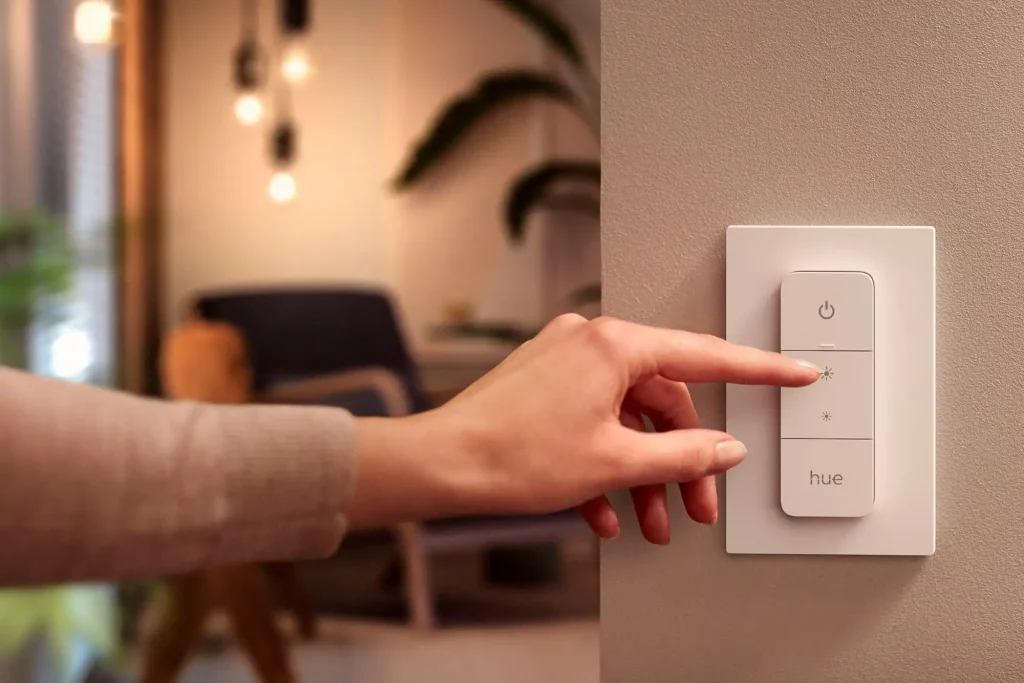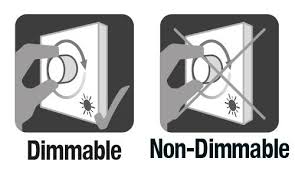The Difference Between Dimmable and Non-Dimmable LED Fixtures August 24, 2016 – Posted in: Lighting Information, General Info

Table of Contents
Retrofit LED lights are sold in a variety of designs but they usually come in two distinct versions: dimmable and non-dimmable, and you may need a brief description of each type when selecting LED lamps for your space. The mood and visual appearance of your space can be altered simply by dimming LED lights and introducing different shades of color to blend in with the light.
Dimmed lights mean a reduction in energy consumption and the best part is that you can use dimmable LED lamps within a non-dimmable circuit. It should be noted that non-dimmable lamps are not designed to work in a dimmable circuit as both lamp and circuit may get damaged. Users should have an easy time selecting a lamp and matching circuit because the lamps are clearly marked as dimmable or non-dimmable.
A Small Explanation Of Dimmers
So a dimmable LED light fixtures must have the ability to:
• Deal with a wide range of source voltage including part-formed sine waves, which is not easy for the control logic.
• Detect from the source voltage the light level that an individual wants, and then give that light level.
CFL/LED dimmers reduce power by turning the power on, and then off for a set period of time (i.e. “on for ten milliseconds, off for five milliseconds”; as opposed to TRIAC dimmers’ which will be “on for as long as the phase is not x degrees or close to the peak power”). This still lowers RMS power over the whole waveform, but it does this in a way that LEDs and CFLs respond to much more readily.
New Vs Old Dimming Styles

Modern dimmers are made to work in high-power circuits and have a mechanism that allows them to dim light from a traditional filament by altering the voltage: but LED lamps have a different functionality. They operate in much lower voltages and are fairly composite. Each LED bulb contains a rather complex in-built circuitry (or a driver) that converts high-voltage AC input current to low-voltage DC current to power the device.
Most LED light bulbs on the marketplace are actually dimmable, if you are using a CFL/LED dimmer.
Your “standard” dial or monitor dimmer is either just a potentiometer or Rheostat that reduces voltage through a certain amount of resistance, or a somewhat better design called a TRIAC dimmer, which runs on a specialized transistor design to attenuate the line voltage by turning the line on / off based on where the AC is in its “phase” or rhythm”.
The LED industry doesn’t refer to the same blueprint for the circuitry design and as a result, driver specifications vary across different brands and models. Dimmers installed in homes and offices today are of different specifications (for instance electronic, training-edge, leading-edge and resistive); therefore when installing new types of LED lamps there’s usually a matching of old and new technology.
The circuitry inside dimmable lamps tends to be universally compatible with a wide range of dimmers but there are a few notable conflicts. For instance, LED lamps work more efficiently when plugged to trailing-edge dimmers than they do when used with leading-edge dimmers. There’s also concern about compatibility based on the minimum load which may be too high for LED lamps in some cases.
A 60W filament lamp may use a dimmer with a load limit of 25W but installing an LED lamp with a power rating of less than 10W makes the two distinct lamps incompatible due to the difference in power consumption. A dedicated LED dimmer will normally have a very low minimum power rating.
As for the dimming experience, the quality of the dimmed light is determined by the functioning capacity of the driver and whether or not this inner chip is compatible with the dimming circuit. Because of the varying types of lamps and dimmers, it’s unlikely that all models of lighting would be compatible with every dimmer. For example our linear office lights come in several customized dimming options depending on the building and control system.
Filament lamps have a higher dimming range when compared to LED, and a few observable functionality issues may occur when a dimmer is connected to the wrong LED lamp. Here are several telling signs that your dimmer may not have been designed to work with your LED lamp:
· Flickering-this may occur in the case of non-dimmable lamps.
· Irregular lighting-when powering the lamp, light output may not transition linearly from bright to dim.
· Failure-the driver, circuit or lamp is damaged or fails.
· Drop-out-this means no visible light output.
· Dead-travel-when adjusting the dimmer, there should be an immediate and obvious change in light output. However, in the case of dead-travel, no observable change in output is recorded.
· Multiple lamps – issues do become apparent when you add multiple lamps.
· Below minimum load- This happens when the LED’s lamps power load is below the minimum needed by the dimmer.
· Mixed models- Different LED models will very likely have varying drivers – since drivers behave in a different manner this could lead to dimming issues.
How To Prevent Dimming Failures
- Schedule regular upgrades for your dimming circuitry and ensure to install good dimmers made specifically for LED.
- When purchasing dimmable LEDs for your circuitry, take time to verify compatibility with your circuitry-this will prevent instances of failure or poor lighting.
- If you rarely use your dimming circuitry, have it changed to non-dimming.
- When purchasing LED lamps and accompanying fitting for your space, consider going for the same brand or model as this will ensure that all lamps have the same driver.
- Buy lighting that uses a remote control dimming function.
It is recommended that before making significant adjustments to the circuitry or other complicated task, always consult with a qualified electrician to stay safe.
I have been the project manager for Modern.Place since early 2016, spending three of those years working overseas on the manufacturing & procurement side of the LED lighting industry. Constantly learning and passing on knowledge to others while excited for what the lighting industry will involve into next.



10 Comments
sue March 05, 2019 - 07:17
What makes the lamp fixture (chandelier) itself be labeled “Dimmable: No”? I am replacing a dimmable fixture with a dimmer switch pre-existig but many of the chandeliers that I am considering are labeled “dimmable: no”. Can I safe use them on a dimmer with dimmable lamps?
Vitaliy Vinogradov March 05, 2019 - 14:37 – In reply to: sue
Great question! If the fixture is a bulb fixture (non LED), it can be dimmed with a TRIAC dimmer. If the fixture is an LED fixture the LED driver / power supply will determine if the fixture is able to be dimmed. The LED driver will also specify the type of dimmer that’s best compatible with the light (O-10v, TRIAC, PWM, etc) .
George December 06, 2019 - 21:18
My customer purchased recessed hi hats with dimmable led drivers. There isn’t a dimmer circuit available. Can I just wire the drivers on the line voltage side and worry about dimming? And how would I do so?
Vitaliy Vinogradov April 27, 2020 - 17:11 – In reply to: George
Hello,
There is several solutions, things like PowPaks from Lutron can help you control them wirelessly via remote. With 0-10v you can just leave the wires if the project doesn’t require dimming as well.
Thanks,
Modern Place
Eva February 06, 2020 - 15:23
Hello Sir/ Ma’am, Thank you for responding this very specific questions. I have selected a chandelier I like however it is a non dimmable unit ( circuit I guess). It takes maximum 60 watt candelabra lights. It is quite frustrating because this is the light fixture I want for this project ( most suited). What can I do in order to make it work as dimmable?. Please advice. Thank you for your expertise.
David April 06, 2020 - 06:55
I am getting no response from a dimmer. To test the circuit can I connect the dimming LED trial driver ( PowerLED uvc1225TD) directly to a switch without a dimmer
Vitaliy Vinogradov April 27, 2020 - 17:02 – In reply to: David
Hello,
Yes David. You can test LED drivers directly without using an in-wall dimmer. Typically the issue is an incorrect match (type of dimmer) or faulty LED driver / dimmer.
Thanks,
Modern Place
Delwyn Goff May 06, 2020 - 17:09
I purchased a 4ft LED wrap light. Is it dimmable? If so what dimmer will work?
Vitaliy Vinogradov May 07, 2020 - 13:55 – In reply to: Delwyn Goff
You would need a dimmable LED driver that matches it, but the LED’s should be dimmable.
Roxy August 08, 2020 - 14:29
I like these modern LED track lights on this article. Where can I get them?